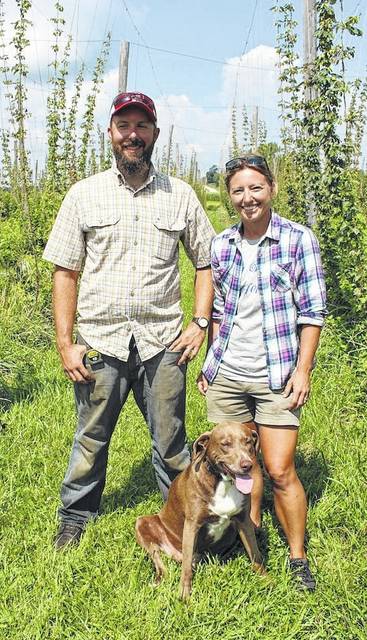
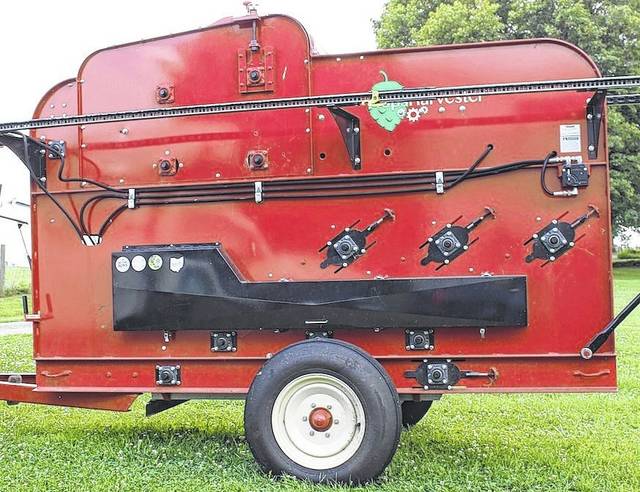
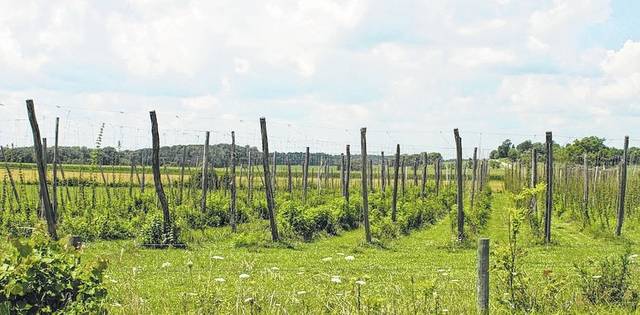
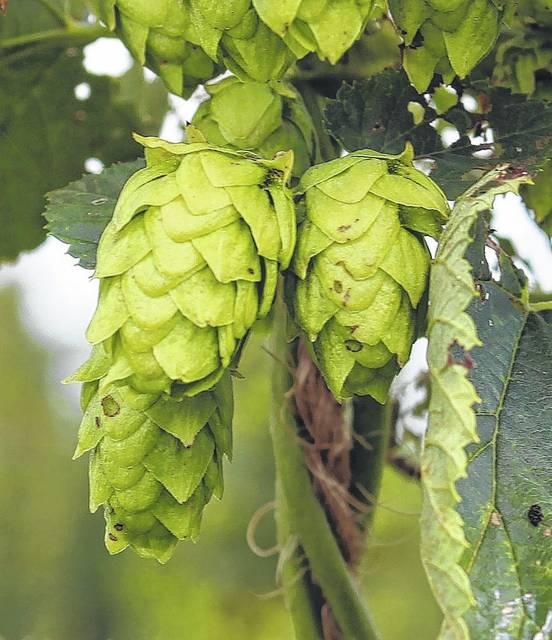
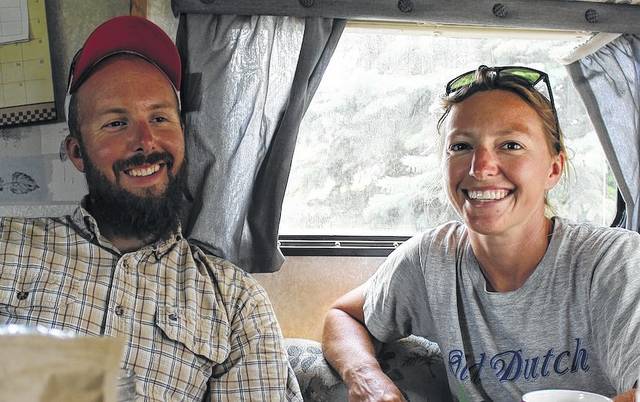
On a back road in Highland County, behind the Old Dutch Cemetery — a graveyard that dates back to the American Revolution — sits the Wilson family farm. The 250-acre plot of land, which has been in the family for more than 75 years, is home to two generations of farmers.
The elder, John Michael “Mike” Wilson, oversees the traditional farming practices such as harvesting corn and hay, carrying on the tradition of his parents who purchased the farm in the years preceding World War II.
However, Wilson’s daughter, Amanda, and her husband, Brady Kirwan, occupy a 2-acre stretch of that land where they hope to both carry on the torch as third generation farmers and start something new — organic hops production.
Journey home
Kirwan and Wilson operate the state’s first Ohio Ecological Food and Farm Association’s Certified Organic hops yard. Named after the neighboring graveyard, Old Dutch Hops is home to six varieties of hops plants including Cascade, Chinook, Magnum, Nugget, Columbus and Centennial.
“We were deciding on coming back here and started doing some research on what to start with,” Kirwan said. The two met in Kirwan’s home state of California while working as park rangers at Yosemite National Park. Kirwan had been working as a laborer for the park and Wilson was exploring an interest in park services after receiving her degree from Ohio University.
She found that she had a growing interest in farming and for being back home.
A growing trend
Kirwan began research into the subject of hops farming, particularly with regard to the work that Brad Bergefurd, a horticulture specialist with The Ohio State University, was doing into the subject. Bergefurd and his team operate a number of test hops yards at the OSU South Centers in Piketon.
According to Ohio State’s College of Food, Agricultural, and Environmental Sciences website, “The Ohio Department of Liquor Control handed out more alcohol-manufacturing permits in the first six months of 2011 than it did all of 2010.” This spike started a trend that has continued in some capacity in the subsequent seven or eight years.
Many brewery, pub, tavern and bar patrons might see the effects of these statistics on the menus of their favorite beer-serving establishments. Craft and microbreweries are competing for page space with many of the nationally-recognized beer brands.
With the growing trend of micro-breweries popping up around the state comes the demand for more hops being grown locally. That’s where people like Wilson and Kirwan come in.
They are part of the Ohio Hops Growers Guild (OHGG), an organization formed in 2014 with the goal of uniting Ohio hops growers and creating a standard of quality and practices. Since that formation, the group has grown to more than 80 members whose primary focus is bringing information about locally-sourced hops to fellow growers and the general public.
On July 22, the OHGG sponsored an open house for nine hops yards around the state. Those interested in the subject could tour their local yards and learn about the whole subject of hops farming. Among the stops was Old Dutch Hops and their Hillsboro yard.
The process
“I think we like the idea of bringing diversity back to the way farms used to be,” Wilson said. Rather than solely focusing on the large crops of the surrounding fields, the couple decided to try their hand at something different. “I think that’s what drew us to it, also. It’s such an odd crop,” Kirwan said.
The set-up of a hops yard with its trellis system is an interesting sight among the traditional fields of soybeans and corn. With the exception of the height difference, the process is not dissimilar to the makeup of a grape vineyard.
The hops are grown on vines which crawl up strands of rope made of coconut fiber, and the ropes dangle from metal wires which are attached to 20-foot, wooden poles. They are planted in long rows, divided by open patches of grass. For Wilson and Kirwan, they use two of these open rows to house chickens.
“We are interested in the idea of sustainability and as much organic farming as we can,” Wilson said. “The chickens feed off the land and help to fertilize it.”
The technique of pasteurizing the chickens in this way is attributed to Joel Salatin, a Virginia farmer known for his unique approach to the world of farming. That approach and thought-process is something that appeals to Wilson and Kirwan.
“A lot of people mis-characterize hops as an easy crop to grow,” Kirwan said. “It is and it isn’t.” Once the crops are in the ground and growing, weeding and watering is about their only maintenance. However, the accessibility of the crop leaves it open to insects.
“We’ve had some problems this year with bugs, especially the Japanese beetles,” said Kirwan, referring to the torn leaves of the hanging plants. For the most part, other growers are having the same issues.
Growing a business
Wilson and Kirwan sell their Old Dutch Hops products at two farmer’s markets, the Northside Farmers Market in Cincinnati, and the Hillsboro Farmer’s Market closer to home. They also sell to the Fibonacci Brewing Company in Cincinnati, a company with which they have a good working relationship. Wilson and Kirwan sell their hops at $6 per pound for wet hops and $15 per pound for dry hops.
The Ohio Department of Agriculture has recently complicated the process by changing the rules for the pelletizing process with regard to water content in harvested crops. The state has also shut down the Ohio’s only commericial-sized hops pelletizing machine, which makes the hops grower’s ability to begin selling more problematic.
“It’s slowed down the process. But we have made more this year than we’ve put in,” Kirwan said. “But with harvesting labor and transportation, it’ll take more time to actually see a profit.” As with any type of farming, the profitablity lies in the process of learning how to grow their yield.
The Old Dutch Hops adventure is a more than two-year project for the couple and something they hope to continue.
“We haven’t figured out how to do it 100 percent,” Wilson said. “But we’d like to get to the point where it’s more sustainable.” Wilson works as a paramedic and Kirwan an EMT, both part-time.
“We mostly do it to help pay for supplies and the animals,” Wilson said. They split their time between the hops yard, work, and learning how to farm.
Eventually, they would like to learn enough about it to make farming their lives. They hope to keep the hops yard part of the process and to incorporate the ideas of true, sustainable farming intact. For them, it starts with experimentation and discovery. According to Wilson, they are still working on finding their place in the world of farming.
“That’s the part we haven’t quite figured out yet,” she said.
Rural Life Today writer Michael Williamson can be reached at 740-852-1616, ext. 1619. This article appears in the upcoming August edition of Rural Life Today, a publication of AIM Media Midwest.






